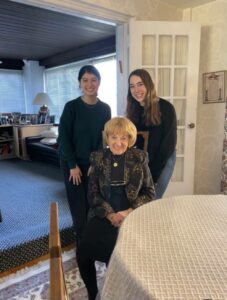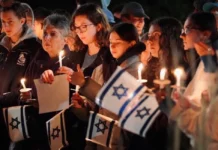
When Bryn Mawr College junior Cavan Helmering first met 94-year-old Betty Sved in her Lower Merion home, she saw Sved and her son in the middle of a trivial argument about the details of a story.
“It really reminded me of my own family and my great-uncle and great-grandmother, kind of the classic Jewish family,” she said.
Sved is a Holocaust survivor, born in Czechoslovakia, who was sent to Auschwitz, then a Czechoslovakian factory, which United States forces later liberated. Every Sunday for almost two months, Helmering and Haverford College student Callie Rabins visited Sved to learn her story, before, during and after the Holocaust.
The students had the opportunity to befriend Sved through The Joseph Gringlas Stories That Live, a Holocaust storytelling fellowship created by the Rohr Center For Jewish Life, the Chabad house for Bryn Mawr, Haverford and Swarthmore College students, that connects students to Holocaust survivors and culminates in a student-generated retelling project. Stories That Live creates an exhibit of these projects at the end of the school year and invites survivors to speak at events throughout the year.
Since its 2015 origins, Stories That Live has expanded from fewer than 10 students in the Tri-Co to more than 60 students across six Jewish college communities nationally. Rabbi Eli Gurevitz, head of the Rohr Center for Jewish Life, is hoping to sustain and grow the program in the years to come.
“They’re timeless, inspirational experiences,” Gurevitz said of the fellowship. “All those moments, they’re not just nice little YouTube moments. They are moments that live with people and really change lives and allow people to connect and be inspired and understand their identity and understand the world.”
Gurevitz created Stories That Live in 2015 as a small program for students to build relationships with survivors beyond a one-time presentation. Over an academic year, students got to know survivors beyond their harrowing experiences of the Holocaust.
“Any survivor will tell you that when you only look at their survival story, that’s not their whole selves,” Gurevitz said.
During her experience getting to know Sved, Helmering was inspired by Sved’s resilience and positive attitude toward strife and hardship. But the two shared a budding friendship. Helmering baked her a challah and said Sved was always happy to pick up the phone and have a visitor.
“In our last few meetings, she gave us a blessing to kind of move forward,” Helmering said. “She always hoped the best for us, and she was always happy to talk to us.”
For their retelling project at the end of the year, Helmering and Rabins created a book telling Sved’s story. On most pages was a QR code that readers could scan to hear Sved tell her story firsthand.
Students from Chabad House of Ann Arbor, Chabad on Campus at Vanderbilt University, Chabad at Washington University in St. Louis and others created similar products found on the Stories That Live website.
Stories That Live is funded in part by the Seed the Dream Foundation, created by Marcy Gringlas and Joel Greenberg as a grant-giving foundation.
Gringlas’ father Joseph Gringlas was a Holocaust survivor who participated in Stories That Live in 2019. He died in 2021.
“Through this program, Eli paired my father with these two young women, who came to his home, interviewed him, got to know him, fell in love with him, understood that he was a prolific artist as he shared his paintings that hung throughout his entire apartment,” Gringlas said. “And with Eli’s help, gave him his very first and only art show at Haverford College.”
Stories That Live was renamed The Joseph Gringlas Stories That Live to honor the survivor.
The fellowship is not only critical for the younger generation carrying on the memory of the Holocaust but for a generation of survivors seeking connection in a time of isolation, Gringlas argued.
“It’s mutually beneficial,” she said. “It’s a mitzvah on both sides.”
Gringlas wants to see Stories That Live survive and expand but recognizes that the continuation of the project is urgent. Survivors continue to age and die.
Though an expensive endeavor, Gringlas and Gurevitz hope to see Stories That Live programs exist at every Hillel and Chabad nationwide.
“As long as we’re able to do this, we’re going to do everything we can to do this, to offer these timeless moments,” Gurevitz said.
To refer Holocaust survivors interested in the Stories That Live program, visit storiesthatlive.org/p/survivor-referral.






